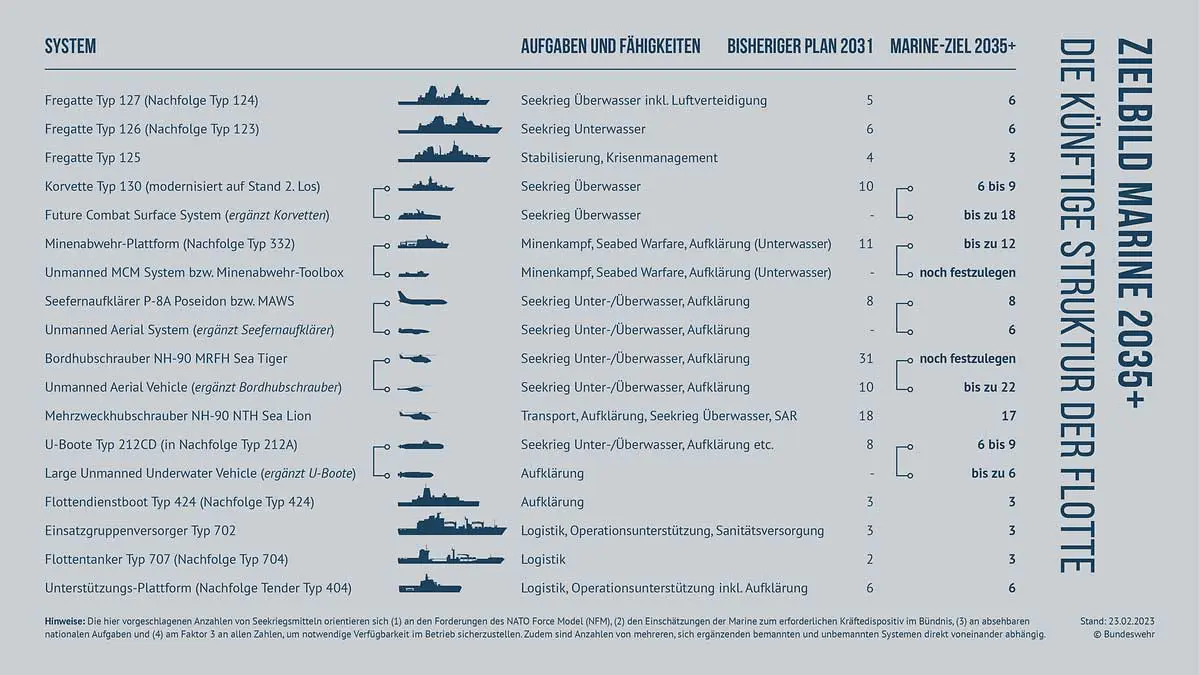In his latest public speech German Navy Chief Vice Admiral Kaack went into detail about what the year 2024 would bring for the German Navy (Marine) in the area of unmanned systems and manned-unmanned teaming (MUM-T) test campaigns.
The German Navy’s desired structure in 2035 (Zielbild 2035) foresees a significant increase in reliance on unmanned capabilities, answering current technological developments and an increasingly difficult recruitment situation.

In order to gain experience with operating unmanned systems in a MUM-T context, the German Navy has set it’s eyes on testing three key systems in 2024.
The first system to be tested this year is the BlueWhale manufactured by IAI jointly with Atlas Elektronik. The BlueWhale is a 10m long 5.5t heavy uncrewed submarine with a relatively broad mission spectrum. The German Navy’s desired configuration includes a Atlas sonar suite with both a hull mounted sonar and a compact low frequency towed array sonar system (LFTAS). The system’s mast can also house additional optronics or electronic support measures (ESM) payoads. In this configuration the system is capable of reaching speeds of up to 7 knots with an endurance of up to 30 days.

BlueWhale will be tested with the Marine’s 212 class submarines and research vessels equipped with a LFTAS. The campaign’s aim is to reliably demonstrate reliable and combat effective operation in conjunction with manned vessels. Additionally the tests will help to demonstrate multi-static sonar detection techniques to better track enemy submarines.
Besides the under water domain the Marine also plans to expand it’s proficiency in operating unmanned aerial vehicles. To expand the type envelope of fielded UAVs beyond smaller rotary wing assets like the UMS Skeldar the German Navy has opted for leasing a General Atomics MQ-9B Sea Guardian. The Sea Guardian is a navalised variant of the common MQ-9 Reaper drone fielded by many NATO allies.

Sea Guardian features a range of maritime sensors, including radar kits and sonobuoy pods for anti-submarine warfare (ASW). Depending on flight conditions and payload the UAV encompasses a mission radius of up to 1200 nautical miles with a maximum endurance of 30 hours.
The type will be put through it’s paces in a campaign spanning multiple months, with missions centered around working with the P-8 Poseidon Maritime Patrol Aircraft (MPA), eight of which the German Navy is receiving in the following years.
Further aerial testing will be conducted together with the German Air Force, which will provide their Heron-TP UAV for naval evaluations. It is also noted that the Luftwaffe and Marine will jointly evaluate the capabilities of small Remote Carrier (RC) prototypes planned to be fielded as part of the wider Future Combat Air System (FCAS) program.
The Luftwaffe has also signed contracts for the acquisition of 21 Airbus EuroMALE UAV systems, marketed for potential use in maritime operations. However, the outcome of the forthcoming test campaigns is currently uncertain. It is yet to be determined whether Airbus and other competitors can secure a position in potential competitions following potentially successful tests with Sea Guardian and BlueWhale. The new plans suggest a relative urgency in deploying these capabilities, as emphasized by Vice Admiral Kaack. The decisive factor for the German Navy’s entry into the unmanned naval warfare domain still hinges on the ongoing budgetary constraints it faces.
